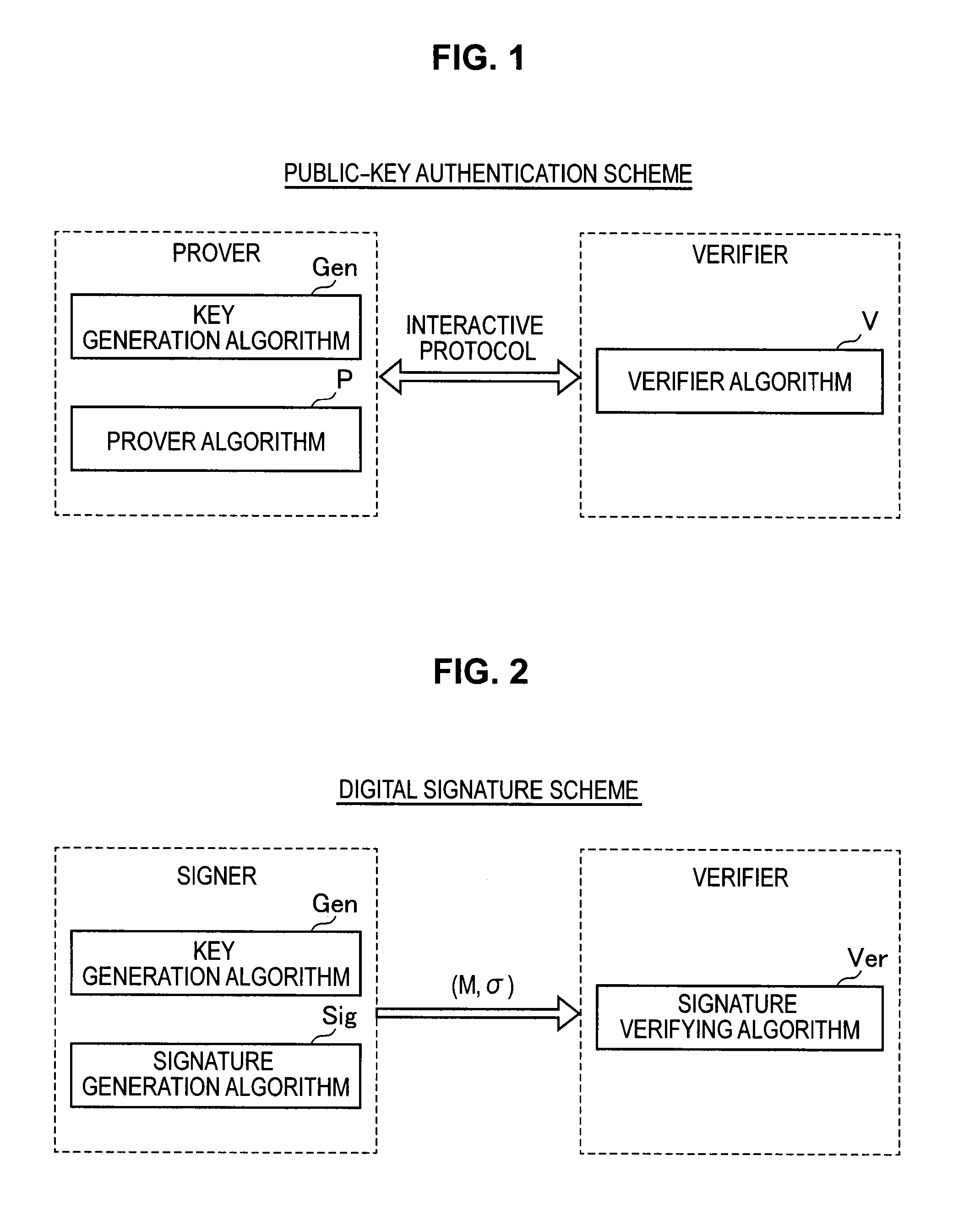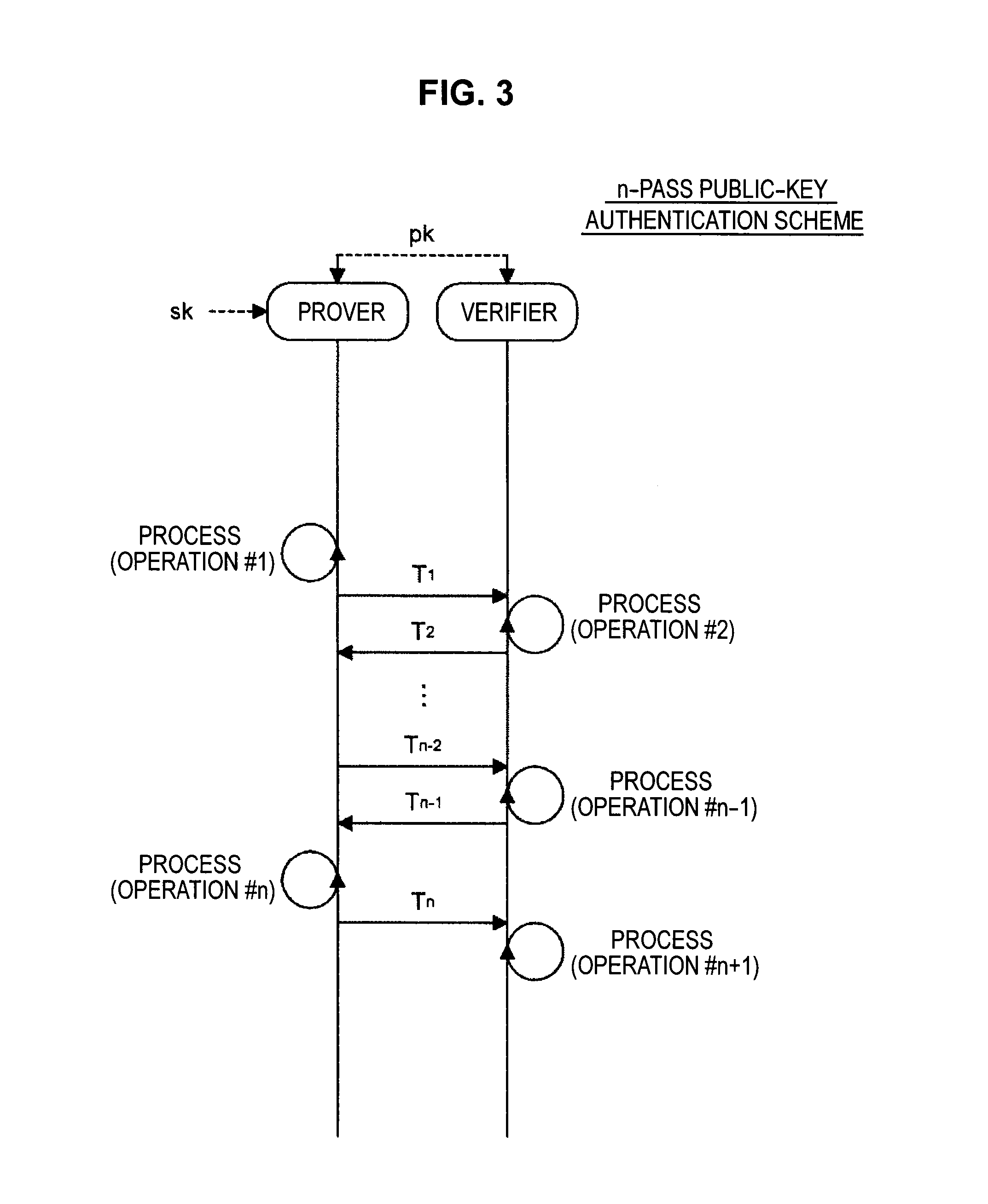Signature verification apparatus, signature verification method, program, and recording medium
- Summary
- Abstract
- Description
- Claims
- Application Information
AI Technical Summary
Benefits of technology
Problems solved by technology
Method used
Image
Examples
example 1
[0315]
for L = 1 to M for I = 1 to N for J = I to N [Lth bit of f] {circumflex over ( )} = [aLIJ]& [Ith bit of x]& [Jth bit ofx]; end for end for end for output f;
[0316]On the other hand, as illustrated in FIG. 20, when the coefficients are structured and generated random numbers are applied sequentially some at a time as the coefficients of the multivariate polynomial, a coefficient substitution algorithm is expressed as in (example 2). In the case of (example 2), an L-bit AND operation (&) is executed merely 2×N×(N−1) / 2 times and an M-bit XOR operation (A) is executed merely N×(N−1) / 2 times. Also, aIJ (1 to M) are generated at a timing of each loop. The coefficients may be used in reverse. For example, when a loop is executed N(N−1) / 2 times, [aIJ (1 to M)] may not be generated every time, but may be generated only once every M times. Also, during a loop of L times, [aIJ (1 to M)] may be used whiling rotating them bit by bit.
example 2
[0317]
for I = 1 to N for J = 1 to N [1st to Mth bits of f] {circumflex over ( )} = [aIJ (1 to M)]& [Ith bit of x]& [Jth bit of x]; end for end for output f;
[0318]As illustrated in FIG. 20, the coefficients may be structured and an intermediate result obtained by applying the coefficients of the multivariate polynomial may be stored in a table. In this case, the coefficient substitution algorithm is expressed as in (example 3). Also, aIJ [x1, . . . , xk] [z1, . . . , zk]=(a(k(I−1)+1)(k(J−1)+1) & x1 & z1)̂ . . . ̂(a(k(I−1)+1)(k(J−1)+k) & x1 & zk)̂ . . . ̂(a(k(I−1)+k(k(J−1)+1) & xk & z1)̂ . . . ̂(a(k(I−i)+k)(k(J−1)+k) & xk & zk) are stored in arrays aIJ [0] [0] to aIJ [2k−1] [2k−1], respectively. In the case of example 3, an L-bit XOR operation (̂) is executed merely (N / k)(N / k−1) / 2 times. However, a necessary memory amount is 22k / k2 times the memory amount of the algorithm of (example 2).
[0319]For example, when k=1, the L-bit XOR operation is executed 120*119 / 2=7140 times, a ...
example 3
[0320]
for I = 1 to N / k for J = I to N / k [1st to Mth bit of f] {circumflex over ( )} = [a IJ(1 to M) [k(I − 1) + 1th to kth bitsof x] [k(J − 1) + 1th to kth bits of x]; end for end for output f;
[0321]The coefficient substitution algorithm according to the structuring technique #1 has been described above. In the structure, a process can be expected to be executed at a high speed when the algorithm is executed.
[0322](7-2-2: Structuring Technique #2 (FIG. 21))
[0323]Next, structuring technique #2 will be described. As illustrated in FIG. 21, structuring technique #2 is a technique for expressing a multivariate polynomial in a quadratic form and collecting the rows and the columns of the quadratic form as one data structure. In the example of FIG. 21, the data structure is collected in the row direction.
[0324]As illustrated in FIG. 21, when the coefficients are structured and the generated random numbers are applied sequentially some at a time as the coefficients of a multivariat...
PUM
 Login to View More
Login to View More Abstract
Description
Claims
Application Information
 Login to View More
Login to View More - R&D
- Intellectual Property
- Life Sciences
- Materials
- Tech Scout
- Unparalleled Data Quality
- Higher Quality Content
- 60% Fewer Hallucinations
Browse by: Latest US Patents, China's latest patents, Technical Efficacy Thesaurus, Application Domain, Technology Topic, Popular Technical Reports.
© 2025 PatSnap. All rights reserved.Legal|Privacy policy|Modern Slavery Act Transparency Statement|Sitemap|About US| Contact US: help@patsnap.com



